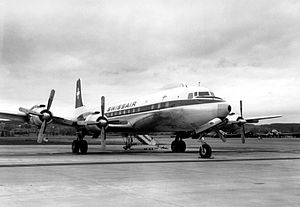Northwest Orient Airlines Flight 1-11
 A SwissAir Douglas DC-7, similar to the aircraft involved in the accident. | |
| Accident | |
|---|---|
| Date | July 14, 1960 |
| Summary | Ditching after an in-flight engine failure and fire |
| Site | 8 km (5.0 mi) northeast off Polillo Island, Philippines |
| Aircraft | |
| Aircraft type | Douglas DC-7C |
| Operator | Northwest Orient Airlines |
| Registration | N292 |
| Flight origin | Undisclosed airport in New York City, United States |
| Stopover | Seattle–Tacoma International Airport, Washington, United States |
| 1st stopover | Anchorage International Airport, Alaska, United States |
| 2nd stopover | Tokyo International Airport, Japan |
| 3rd stopover | Okinawa-Naha Airport (OKA/ROAH), Japan |
| Destination | Manila International Airport (MNL/RPLL), Philippines |
| Occupants | 58 |
| Passengers | 51 |
| Crew | 7 |
| Fatalities | 1 |
| Injuries | 44 |
| Survivors | 57 |
The crash of Northwest Orient Airlines Flight 1–11 was an accident involving a Douglas DC-7C of the American airline Northwest Orient 8 km (5.0 mi) northeast off Polillo Island, Quezon, Philippines, on July 14, 1960. Of the 58 people on board, 57 survived with 44 suffering from minor injuries and one female passenger losing her life.[1]
Accident
[edit]In the evening of July 13, 1960, at 11:25 pm, Flight 1–11 landed at Okinawa-Naha Airport on the Japanese island of Okinawa, which was its last intended stopover of its journey from New York City, United States, to Manila, Philippines. The other stopovers included the American cities of Seattle, Washington, and Anchorage, Alaska, as well as Japan's capital Tokyo.[1]
The aircraft readied itself for the last leg of its journey to Manila and took of from Okinawa-Naha Airport at 1:12 am on July 14. Around two hours after takeoff at 3:15 am, engine no. 2 underwent a sudden loss of power which was indicated to the plane's crew by a drop in mean effective pressure and manifold pressure. The crew believed that the origin of the problem lay with carburetor icing and so took action to correct the issue. When no improvement was made to the situation of engine no. 2, the captain noticed the oil-out temperature of the engine rising. The crew thereafter attempted to feather the propeller of engine no. 2, but failed numerous times. Following the ongoing engine troubles, the flight was cleared to descend from FL180 18,000 ft (5,486 m) to FL100 10,000 ft (3,048 m). The crew declared an emergency at 3:40 am while descending to 9,000 ft (2,743 m). In an effort to halt engine no. 2 rotation, the crew attempted to activate the firewall shutoff valve so the engine would be deprived of lubricant. As a result, the propeller separated from engine no. 2 and slashed a 15-inch (380 mm) hole in the plane's fuselage. More damage was reported by a continuous fire alarm, alerting the crew of a fire in engine no. 2 which had also spread to the wing. The crew informed Manila of their predicament at 4:20 am before the plane undertook a rapid descent which was lessened in intensity when the plane reached an altitude of 1,000 ft (305 m). The crew had no choice but to ditch the aircraft in the Pacific Ocean about 124.7 km (77.5 mi) northeast of Manila and 8 km (5.0 mi) northeast off Polillo Island, Quezon Philippines. Upon hitting the water at 4:30 am, the tail of the aircraft sheared off alongside the right wing and all engines.[2]
The right wing remained afloat for three hours following the crash, working as a makeshift liferaft for many survivors, while the remainder of the aircraft sank between 8 and 10 minutes after the ditching. The survivors were ultimately rescued by the US Coast Guard and US Navy some four to six hours after the crash. Of the 58 passengers and crew, 57 survived with 44 suffering minor injuries. A single passenger died when the engine no. 2 propeller slashed through the plane's fuselage and struck her.[3]
Aircraft
[edit]The Douglas DC-7C involved, N292 (msn 45462/925) was built in 1958 and was used by Northwest Orient Airlines from 1958 until its destruction in 1960.[1]
Aftermath
[edit]The aircraft was torn apart by the impact with the wreckage sinking to the bottom of the Pacific. An investigation of the accident concluded that an internal failure of the no. 2 engine had caused the plane's oil supply to be contaminated, resulting in a loss of oil supply and therefor the subsequent damage to the engine which ended with the propeller detaching after its assembly was disturbed, and engine fire that spread to the plane's wing, making a ditching of the aircraft necessary.[1]
References
[edit]- ^ a b c d "Accident Description". aviation-safety.net. Aviation Safety Network. Retrieved November 5, 2022.
- ^ "Accident Details". planecrashinfo.com. Retrieved November 6, 2022.
- ^ "Northwest Airlines History Center". northwestairlineshistory.org. Retrieved November 6, 2022.
External links
[edit]- Northwest Airlines accidents and incidents
- Airliner accidents and incidents caused by engine failure
- Airliner accidents and incidents caused by in-flight fires
- Airliner accidents and incidents involving ditching
- July 1960 events in Asia
- 1960 in the Philippines
- Aviation accidents and incidents in 1960
- Accidents and incidents involving the Douglas DC-7
- Aviation accidents and incidents in the Pacific Ocean
- 1960 disasters in Oceania
- 1960 disasters in the Philippines
